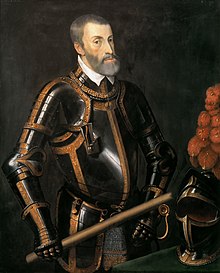Charles V, Holy Roman Empire
| Charles V | |
|---|---|
 |
|
| Reign | 28 June 1519 – 27 August 1556 |
| Coronation |
|
| Predecessor | Maximilian I |
| Successor | Ferdinand I |
| King of Spain | |
| Reign | 23 January 1516 – 16 January 1556 |
| Predecessor |
Joanna (Castile) Ferdinand II (Aragon) |
| Successor | Philip II |
| Co-monarch | Joanna |
| Reign | 25 September 1506 – 25 October 1555 |
| Predecessor | Philip IV |
| Successor | Philip V |
| Archduke of Austria | |
| Reign | 12 January 1519 – 28 April 1521 |
| Predecessor | Maximilian I |
| Successor | Ferdinand I |
| Born |
24 February 1500 Ghent, Flanders, Habsburg Netherlands |
| Died | 21 September 1558 (aged 58) Yuste, Spain |
| Burial | El Escorial, San Lorenzo de El Escorial, Spain |
| Spouse | Isabella of Portugal |
| Issue |
Illegitimate:
|
| House | Habsburg |
| Father | Philip I of Castile |
| Mother | Joanna I of Castile |
| Religion | Roman Catholicism |
| Signature |  |
Charles V and I (German: Karl; Italian: Carlo; Latin: Carolus; Spanish: Carlos; Dutch: Karel) (24 February 1500 – 21 September 1558) was ruler of both the Spanish Empire as Charles I from 1516 and the Holy Roman Empire as Charles V from 1519, as well as of the lands of the former Duchy of Burgundy from 1506. He voluntarily stepped down from these and other positions by a series of abdications between 1554 and 1556. Through inheritance, he brought together under his rule extensive territories in western, central, and southern Europe, and the Spanish colonies in the Americas and Asia. As a result, his domains spanned nearly four million square kilometers and were the first to be described as "the empire on which the sun never sets".
Charles was the heir of three of Europe's leading dynasties: the Houses of Valois-Burgundy (through his paternal grandmother), Habsburg, and Trastámara (his maternal grandparents were the Catholic Monarchs of Spain). He inherited the Netherlands and the Franche-Comté as heir of the House of Valois-Burgundy. From his own dynasty, the Habsburgs, he inherited Austria and other lands in central Europe. He was also elected to succeed his Habsburg grandfather, Maximilian I, as Holy Roman Emperor, a title held by the Habsburgs since 1440. From the Spanish House of Trastámara, he inherited the crowns of Castile, which was in the process of developing a nascent empire in the Americas and Asia, and Crown of Aragon, which included a Mediterranean empire extending to Southern Italy. Charles was the first king to rule Castile and Aragon simultaneously in his own right and as a result he is often referred to as the first king of Spain. The personal union, under Charles, of the Holy Roman Empire with the Spanish Empire resulted in the closest Europe would come to a universal monarchy since the death of Louis the Pious (778–840).
...
Wikipedia
